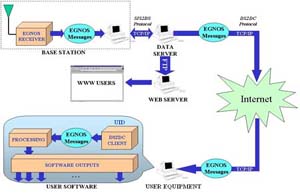|
SISNeT
PLATFORM OVERVIEW
 |
 |
|
Architecture of
the SISNeT platform
|
|
The four main components of the SISNeT platform are:
- Base Station (BS)
A PC computer connected to an EGNOS receiver through
a serial port. Several software components are installed
on the computer, so that EGNOS messages can be obtained
and sent to a remote computer (called Data Server) in real-time.
- Data Server (DS)
A high-performance computer, optimised for running server
applications with many users connected at the same time.
The DS functionality is implemented through a software application
called SISNeT Data Server (SDS). This software receives
the EGNOS messages from the BS and transfers them to the
remote SISNeT users in real time. In addition, the SDS implements
all the extra services (present and future) provided by
the SISNeT system to the users.
- User Application Software (UAS)
A software application, which design complies with the SISNeT
User Interface Document specifications. The UAS obtains
EGNOS messages in real time (1 message/s or 250 bit/s) from
the DS. The UAS can also access and apply the present and
future additional SISNeT services. Each concrete SISNeT-based
application is characterised by specific processing and
output interface stages, which provide the desired functionality
and user interface to the UAS. The software can be embedded
in different kinds of computers and electronic devices (e.g.
Personal Data Assistants).
- Web server
The DS can store the received messages in a remote Web server
via the FTP protocol, enabling future development of Web
/ WAP applications (accessible to the users through a Web
browser or mobile device).
Presently, the BS and the DS are installed on the ESA
Radionavigation Laboratory in the ESTEC centre (Noordwijk,
The Netherlands). The ESA implementation of the UAS is run
in the EGNOS Project Office (Toulouse, France) where the whole
system is frequently updated. These enhancements are reported
in the SISNeT User Interface Document.
|

